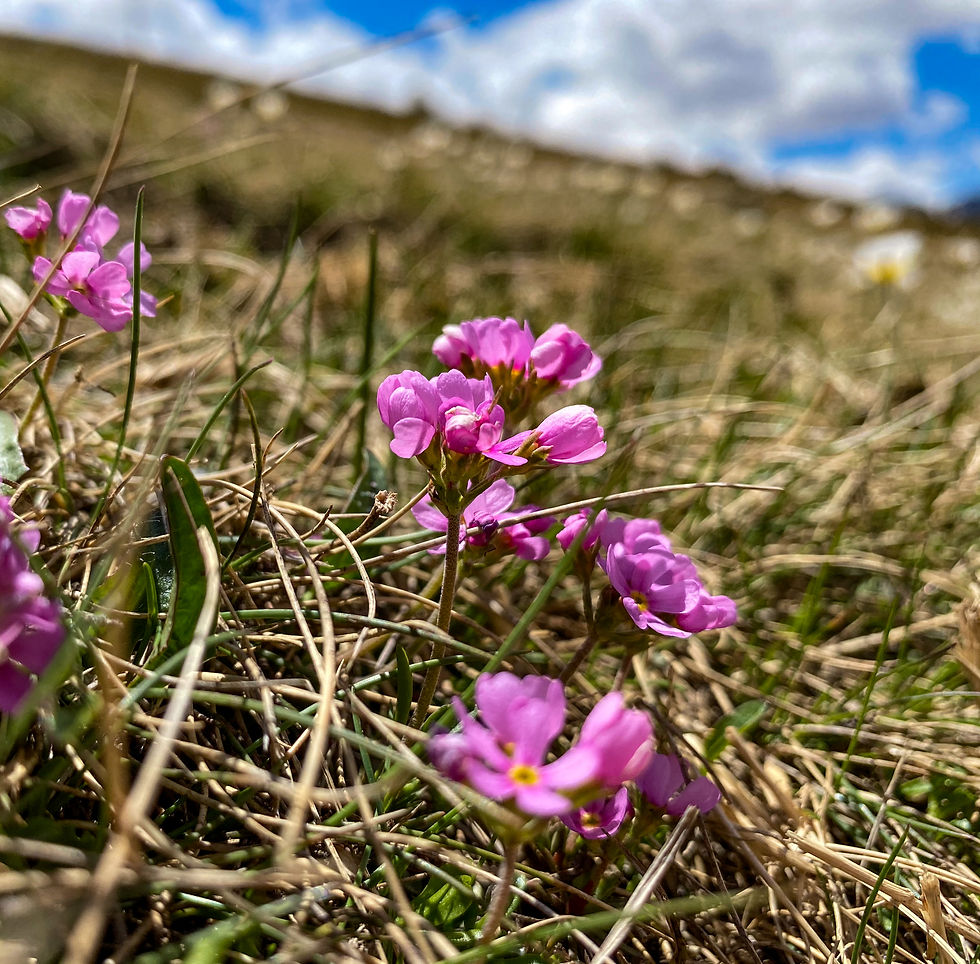The flowers you can find in Andorra
- GUIAND

- May 4, 2021
- 4 min read
Updated: Aug 22, 2023
The esparceta, the golden buttons, the grandalla, the mountain Antilla... These are some of the flora species that we can easily find in the different natural areas of the Principality.

Sainfoin
It is a perennial plant native to the Pyrenees, although it is native to Eurasia. It grows to a maximum of 80 centimeters in height and has 6 to 12 pairs of leaflets. In the past it was used as shoeing for sheep, horses and rabbits. In addition, it gives a highly appreciated monofloral honey.

Buttercups
They are present in a large part of Catalonia, including the Pyrenees. It blooms from March to July and its flowers are 4-15 mm in diameter and deep yellow in color. It lives from sea level to 1,400 meters of altitude.

The mountain antilles
It is recognized by the imparipinnate leaves and by having many small elliptic leaflets. The flowers are grouped in a glomerulus carried by a high peduncle that protrudes from the bush. The petals are usually reddish and pink tones.

It has always been one of the most appreciated flowers in Andorra. It is very perfumed and is associated with poetry and Greek mythology. Its petals are white and it has a yellow central crown with a red finish. It blooms in spring and is used to make more than 10% of current perfumes.

The horn
It is a perennial species native to western Europe and northern Africa. Its petals can be yellow or orange with an oval shape. It is a plant that can be delicate and slow to develop at first, but its persistence is especially good.

Wild safflower
The wild safflower or centaurea jacea is a flower with a curious history. In ancient times, numerous benefits were attributed to it since according to legend it would have been the centaur Chiron who discovered its medicinal properties. Hence its scientific name knapweed. It is a perennial plant that produces flowers of a pinkish hue and is native to the meadows of the forests of Europe.

Wind flower
The wind flower or pulsatila vulgaris is a plant native to Europe. Legend has it that these flowers arose from places where the blood of Roman soldiers had been spilled, probably since they usually appear in ancient burial mounds. It blooms in the shape of a bell and its flowers can vary in color, but are usually purple tones.

The dog's tooth
This plant gets its name from its appearance similar to a dog's tooth. It is a plant that produces a single pink or white flower. When fully open, the petals face the sky and reveal their six stamens and a pistil that attract a lot of attention due to their colors.

The hepatic anemone, also known as liverwort, is a plant that produces white and lilac flowers. It has a very peculiar history since in the Middle Ages it was believed that since its petals were shaped like a liver, they could cure diseases of this organ. But in reality it is a toxic flower since it has protoanemonin.

Vermillion flower spring
It is a very popular plant for its lilac flowers that have great ornamental value. It is believed that due to its early flowering in the Middle Ages it was known as the first-born flower of spring, indicating the beginning of this season.

Scabious bite
The scabious bite is a very important source of food for a large number of butterflies in the Andorran valleys. Infusions with this plant can have health benefits.

Blue gentian
Alpine gentian or blue gentian is a perennial plant native to Europe. It is known for its healing properties in traditional medicine and is used as an antipyretic, digestive and even to lighten skin blemishes as a topical use.

The blue monkshood is the most poisonous flower in Europe, so you have to be very careful with this beautiful but lethal flower. Only 5mg are capable of killing an adult in a healthy state and there is currently no known antidote for its poison. There is also a yellow variety with the same toxicity.

Yellow daffodil
Yellow daffodils are hardy plants and are made up of six petals that surround a trumpet in the center. Their name comes from the Greek myth of Narcissus, but they are currently associated with values of creativity, renewal and vitality.

Burser's gentian
This plant is usually found in the high mountains, so Andorra is the ideal climate for them to grow strong and healthy. They have pale yellow campaign-shaped flowers, and the petals have small dots inside.

Blue iris
This plant comes from the Iridaceae family and can be found in both valleys of Andorra. They usually grow in areas with full sun exposure and reach up to 70 centimeters in height. Its flowers are wide and are usually purple or bluish in color, although they can be found in other colors.

Arnica is a flower popularly known for its medicinal properties as it stimulates regeneration and reduces inflammation. But we must not forget that it can be a toxic plant if consumed in high quantities, so it must be used externally or in homeopathic preparations approved by a doctor.

Tobaco flower
The tobacco flower has a particularly strong link with the history of Andorra since, at the beginning, Andorra was one of the only areas where they were planted. However, it is also a flower that can be found in perfumery, especially in men's fragrances.
REALLY, THE FLORA OF ANDORRA IS VERY EXTENSIVE!...




Comments